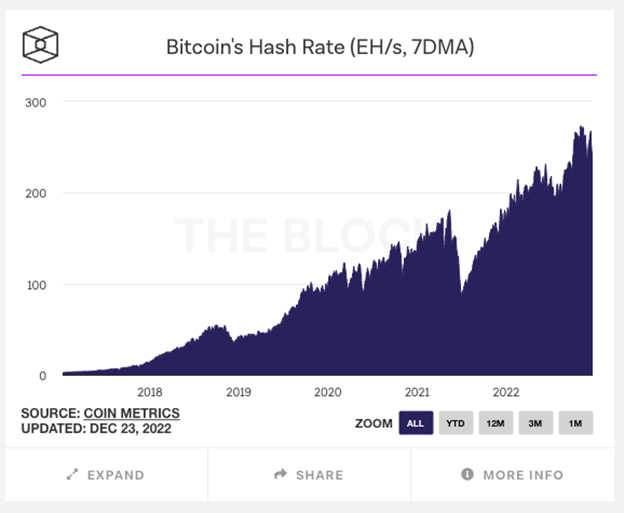2022 is coming to an end, and our staff at NewsBTC decided to launch this Crypto Holiday Special to provide some perspective on the crypto industry. We will talk with multiple guests to understand this year’s highs and lows for crypto.
In the spirit of Charles Dicken’s classic, “A Christmas Carol,” we’ll look into crypto from different angles, look at its possible trajectory for 2023 and find common ground amongst these different views of an industry that might support the future of finances.
We kicked us this special with an institutional guest, asset management firm Blofin. In early December, they wrote an essay called “Catastrophe, Survival, and Evolution: Writing After November’s Crypto Markets” which inspired this series.
Blofin: “One of the apparent signals is that in December 2022, monthly crypto spot volumes have returned to 2020 levels.”
In their essay, the firm argues that the crypto industry has been heavily impacted by the collapse of hedge fund Three Arrows Capital, FTX, Terra (LUNA), and others. These events forced crypto investors into inactivity as their confidence in the sector shattered.
Blofin: “There is no doubt that crypto is the future direction of finance. Still, a series of previous events have shown that if investors’ money cannot be protected, they will eventually give up the crypto market (…).”
But there is light at the end of the tunnel for Bitcoin and other cryptocurrencies; albeit a long recovery is ahead, the nascent asset class will emerge from its ashes. For Blofin, the crypto industry is on the brink of a critical evolution. Once completed, the sector will rise again on the back of new institutional support. This is what they told us:
Q: What’s the most significant difference for the crypto market today compared to Christmas 2021? Beyond the price of Bitcoin, Ethereum, and others, what changed from that moment of euphoria to today’s perpetual fear? Has there been a decline in adoption and liquidity? Are fundamentals still valid?
A: The most significant difference comes from two aspects: liquidity and investor confidence. In 2021, the liquidity of the crypto market is still sufficient, and the impact of the liquidity contraction in the risk asset market has not yet fully manifested. In 2022, with the Fed’s (U.S. Federal Reserve) continuous interest rate hikes, Luna’s collapse, 3AC Capital’s (Three Arrow Capital) bankruptcy, and chapter 11 of the FTX exchange, the liquidity of the crypto market is basically squeezed dry. One of the apparent signals is that in December 2022, monthly crypto spot volumes have returned to 2020 levels.
In addition, the blow to investor confidence from a series of events in 2022 will be huge. At Christmas 2021, institutions and retail investors feel they have a lot to do in the crypto market. At the end of 2022, even professional investment institutions have lost so much due to the collapse of exchanges. As a result, they no longer trust the crypto industry; they feel that there are Ponzi schemes and scammers everywhere. In the end, institutions choose to withdraw funds, followed by retail investors.
However, the number of investors in the crypto asset market is still high. Many people are just not active in a bear market, but that doesn’t mean they have left the crypto market. They are watching and waiting for the best time to buy the dip. Non-Zero on-chain addresses are still increasing steadily, and the hash rate of miners has not been significantly affected by the bear market in 2022.



The influence of fundamentals is still valid for the crypto market, but it is mainly concentrated on the macro perspective. During the bear market period, liquidity is concentrated in BTC and ETH, and it is difficult for altcoins to obtain more liquidity. Therefore, macro factors such as interest rate hikes and strong USD significantly impact BTC and ETH. At the same time, because of the bad liquidity status, improvements in the fundamentals of altcoins and project tokens are difficult to bring about sustained performance improvements.
Q: What are the dominant narratives driving this change in market conditions? And what should be the narrative today? What are most people overlooking? We saw a major crypto exchange blowing up, a hedge fund thought to be untouchable, and an ecosystem that promised a financial utopia. Is Crypto still the future of finance, or should the community pursue a new vision?
A: In our opinion, the changes in the market in 2022 depend on the position of the crypto market in the risk asset system. There is no doubt that crypto assets are at the tail end of the risk asset market due to the high volatility levels of the crypto market and the “Wild West” era it is in. Therefore, once there is any trouble, it is easier for investors to choose to sell and form a run, causing a more significant crisis.
The crypto market in 2022 is somewhat like the Nasdaq in the late 1990s. Adventurers and warriors gained a lot of wealth before 2000 and in 2021, which stimulated more people to come and take risks. Most people ignore the risks and end up with nothing.
Therefore, compliance and security should be an integral part of the future narrative of the crypto market. There is no doubt that crypto is the future direction of finance (faster speed, more programmatic, more global, more reasonable credit system, and more substantial innovation potential). Still, a series of previous events have shown that if investors’ money cannot be protected, they will eventually give up the crypto market and will not continue to pay for the potential of the market and new technologies, even if these technologies have potential and attractiveness.
Q: If you must choose one, what do you think was a significant moment for crypto in 2022? And will the industry feel its consequences across 2023? Where do you see the industry next Christmas? Will it survive this winter? Mainstream is once again declaring the death of the industry. Will they finally get it right?
A: The collapse of FTX is the culmination of the 2022 bear market in the crypto market. The incident interrupted the slow recovery process of the crypto market and aroused widespread concern from regulators in major markets such as the US and the EU. In addition, many institutions have closed down due to the collapse of FTX or encountered operational difficulties and urgently need rescue.
It can be expected that in 2023, the aftermath of the FTX incident may eventually cause some institutions to go bankrupt, and more regulatory policies will also be introduced. In addition, from a macro perspective, due to the continuation of high interest rates, it is difficult for the crypto market to usher in new liquidity, and it will take longer to recover.
However, in the above questions, we have mentioned some characteristics of the crypto market that are difficult to be replaced by traditional markets (faster speed, more programmatic, more global, more decentralized, more reasonable credit system, and more substantial innovation potential). Therefore, as long as investors have trading needs, the crypto industry will continue to exist, but it will become more compliant and secure.
Q: To summarize for our readers, what sectors have been the most resilient in this crisis? Which ones are the most likely to recover in 2023? And how do you see the evolution of the nascent industry playing out?
A: Considering the degree of acceptance, mainstream currencies such as BTC and ETH are still the most resilient sectors in the crypto market. Public chains and crypto infrastructure are also one of the most resilient sectors in the crypto market in the future, for all applications in the crypto market need their support.
In addition, the exchange sector is also quite resilient, for as the market stabilizes and gradually recovers, the trading needs of investors still exist and will start to grow again. Looking back at the history of the crypto market, many exchanges will go bankrupt in each bear period, but new exchanges will emerge in the bear market and shine in a new round of bull.
However, it is difficult to determine who will be the first to recover in 2023. Since there is still a long time before the liquidity faucet reopens, the current liquidity shortage situation is still difficult to improve. The crypto market will likely continue to consolidate at a low level for a long time.
The crypto market is now at the end of the “Wild West”. As the crypto market continues to develop and mature, after the events of 2022, lawmakers will gradually have examples to help, and the regulatory and compliance framework will also take shape. The above may limit the crypto market’s development in some directions, but it is also good for the long-term growth of the crypto market. Under the compliance framework, more funds from traditional markets and other sources can enter the crypto market, and the builders of the crypto market will have more opportunities to obtain investment.

As of this writing, Bitcoin trades at $16,800 with sideways movement across the board. Image from Unsplash, chart from Tradingview.
Credit: Source link






























